Does Decreased Renal Function Predict Worse Outcomes With Newer Antimicrobials?
Numerous studies need to be performed to ensure adequate antimicrobial dosing, partic­ularly in the setting of renal impairment and critical illness.
Highlighted study:
Bidell MR, Lodise TP. Suboptimal clinical response rates with newer antibiotics among patients with moderate renal impairment: Review of the literature and potential pharmacokinetic and pharmacodynamic considerations for observed findings. Pharmacotherapy. 2018;38(12):1205-1215. doi: 10.1002/phar.2184.
In 2013, the US Centers for Disease Control and Prevention (CDC) reported that at least 2 million people are infected by an anti­biotic-resistant infection, and at least 23,000 of those people die each year in the United States.1 A more recent estimate has the actual annual incidence of inpatient and outpa­tient deaths closer to 150,000.2 In response to this global threat, there have been several new antibiotics (Table 1) marketed that target bacteria that are considered to be serious risks by the CDC and World Health Organization.3,4
Antimicrobial therapy targeted to these multidrug-resistant (MDR) bacteria is evolving, particularly in regard to appropriate dosing. Multiple factors must be considered when developing dosing regimens for these new antimicrobials, such as the pharmacoki­netic/pharmacodynamic (PK/PD) parameters, interpatient variability, minimum inhibitory concentration (MIC) breakpoints, and issues with resistance emergence.
Bidell and Lodise looked at using renal impairment dosing guidelines for ceftazidime/ avibactam (CAZ-AVI), ceftolozane/tazobactam (TOL-TAZ), daptomycin, and telavancin and if these dosing recommendations affected outcomes in patients with moderate renal impairment.5 They found that in all 4 phase 3 trials, there was a trend of reduced efficacy in patients with baseline renal impairment. This review will focus on the phase 3 studies which evaluated the antimicrobials CAZ-AVI and TOL-TAZ.
CAZ-AVI plus metronidazole was evaluated in the phase 3 complicated intra-abdominal infection (cIAI) trials RECLAIM 1 and 2 versus meropenem.6 TOL-TAZ plus metronidazole was compared in a similar study, the ASPECT-cIAI trial, versus meropenem for the treatment of cIAI.7 In RECLAIM 1 and 2, response rates were higher with meropenem (74.3%-88%) compared with CAZ-AVI and metronidazole (45.2%-72%), with a between group abso­lute difference range of 16.0 to 29.1 (Table 2). In the ASPECT-cIAI study, response rates were higher with meropenem (69.2%-71.4%) compared to TOL-TAZ with metronidazole (47.8%-72.7%), with a between group absolute difference range of —1.3 to 21.4 (Table 2).

The authors suggest several explanations for these results. The first explanation was possibly unrelated to which antibiotic was chosen in the studies. Interpatient variability, chronic disease state, age and severity of illness, and missing variables assessed as fail­ures were explored.
Additional explanations included PK/PD reasons centered on the limitations of current methods of adjusting dosing in patients with acute renal failure, particularly in those with fluctuating renal function. Both major estimates of renal function equations, the Cockcroft-Gault and modification of diet in renal disease, assume that patients have stable, nonfluctuating renal function. There are also alterations in PK/PD in patients with sepsis. Alterations can include increased volume of distribution, increased drug clearance, and lower plasma concentrations.8 Often, septic patients’ renal dysfunction resolves within the first few days. Early antimicrobial dose reduc­tions based on acutely decreased renal func­tion can also lead to negative outcomes.9
To answer questions raised by this review, numerous studies need to be performed to ensure adequate antimicrobial dosing, partic­ularly in the setting of renal impairment and critical illness, such as therapeutic drug monitoring of beta-lactam antibiotics. Until there are more data, several strategies can be employed. The first is to get an accurate estimate of the patient’s renal impairment. Clinically determining if the patient has acute kidney injury or chronic renal impairment can guide initial dosing of these antibiotics. In the setting of fluctuating renal function, alterna­tive methods of measuring clearance, such as 8- to 24-hour urine creatinine or urine output, can help guide dosing of antibiotics. There is a role for therapeutic drug monitoring of these antibiotics, but standardization and more literature are needed. The final strategy is the utilization of the kinetic estimated glomerular filtration rate equation, but it has not been validated for this purpose.
Although the sample size from the 4 studies are small, there is an indication signal that reduced dosing of CAZ-AVI and TOL-TAZ in patients with moderate renal impairment may decrease the drugs’ efficacy and chance of cure. As a result of the CAZ-AVI study, the recom­mended dose for patients with moderate renal dysfunction is higher than in the RECLAIM 1 and 2 trials. More research is needed to eval­uate the effect of moderate renal impairment in patients who are candidates for antibiotics for the treatment of complicated infections. In severely ill patients, a risk-versus-benefit assessment must be performed to determine if dosage adjustments should be made, especially in the setting of MDR bacteria.
Zimmer is an ID/Antimicrobial Stewardship pharmacist at CoxHealth in Springfield, MO. Drew enjoys fly-fishing, hunting, the St. Louis Cardinals and all things ID. You can find him on Twitter @zimrx17.*Zimmer is a member of the Society of Infectious Disease Pharmacists.
References:
- US Department of Health and Human Services/CDC. Antibiotic Resistance Threats in the United States. Atlanta, GA: CDC; 2013. cdc.gov/drugresistance/pdf/ar-threats-2013-508.pdf.
- Burnham JP, Olsen MA, Kollef MH. Re-estimating annual deaths due to multidrug-resistant organism infections. Infect Control Hosp Epidemiol. 2019;40(1):112-113. doi: 10.1017/ice.2018.304.
- CDC. Antibiotic/antimicrobial resistance (AR/AMR): biggest threats and data. CDC website. cdc.gov/drugresistance/biggest_threats.html.
- Tacconelli E, Carrara E, Savoldi A, et al; WHO Pathogens Priority List Working Group. Discovery, research, and development of new antibiotics: the WHO priority list of antibiotic-resistant bacteria and tuberculosis. Lancet Infect Dis. 2018;18(3):318-327. doi: 10.1016/S1473-3099(17)30753-3.
- Bidell MR, Lodise TP. Suboptimal clinical response rates with newer antibiotics among patients with moderate renal impairment: review of the literature and potential pharmacokinetic and pharmacodynamic considerations for observed findings. Pharmacotherapy. 2018;38(12):1205-1215. doi: 10.1002/phar.2184.
- Mazuski JE, Gasink LB, Armstrong J, et al. Efficacy and safety of ceftazidime-avibactam plus metronidazole versus meropenem in the treatment of complicated intra-abdominal infection: results from a randomized, controlled, double-blind, phase 3 program. Clin Infect Dis. 2016;62(11):1380-1389. doi: 10.1093/cid/ciw133.
- Solomkin J, Hershberger E, Miller B, et al. Ceftolozane/tazobactam plus metronidazole for complicated intra-abdominal infections in an era of multidrug resistance: results from a randomized, double-blind, phase 3 trial. Clin Infect Dis. 2015;60(10):1462-1471. doi: 10.1093/cid/civ097.
- Shah S, Barton G, Fischer A. Pharmacokinetic considerations and dosing strategies of antibiotics in the critically ill patient. J Intensive Care Soc. 2015;16(2):147-153. doi: 10.1177/1751143714564816.
- Roberts JA, Paul SK, Akova M, et al; DALI Study. DALI: defining antibiotic levels in intensive care patients: are current beta-lactam antibiotic doses sufficient for critically ill patients? Clin Inf Dis. 2014;58(8):1072-1083. doi: 10.1093/cid/ciu027.

